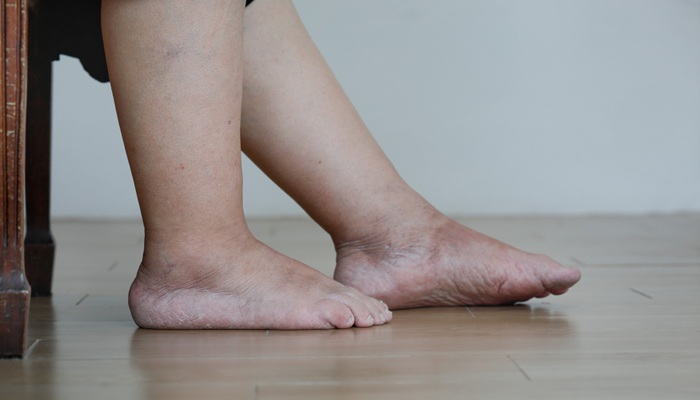Experiencing swollen legs after sitting for a long time isn’t always caused by lack of movement or an uncomfortable position. In many cases, this symptom can signal an underlying issue with your blood vessels, including heart-related conditions such as peripheral artery disease (PAD). This disease restricts blood flow to the legs, leading to various symptoms ranging from swelling to pain. Although often overlooked, PAD is a serious condition that requires proper diagnosis and treatment to prevent complications.
To support patients with this condition, Mandaya Royal Hospital Puri provides care from dr. Suci Indriani, Sp.JP (K), FIHA, a cardiologist and vascular specialist with advanced expertise in interventional cardiology and vascular therapy. She is also experienced in performing revascularization procedures for PAD to help restore blood flow and provide comprehensive treatment tailored to each patient’s needs.
Contents
PAD Symptoms Beyond Swollen Legs After Sitting for Long Periods
Peripheral artery disease (PAD) is a vascular disorder that occurs when the arteries in the legs, pelvic area, or arms become narrowed or blocked, typically due to plaque buildup. This narrowing reduces blood flow to surrounding tissues and can cause various symptoms, including leg pain.
The most common early sign of PAD is leg discomfort during physical activity. This happens because narrowed arteries cannot meet the muscles’ increased demand for blood. As PAD progresses, you may feel pain in the legs or feet even at rest. However, many people experience no symptoms and only discover the condition through screenings.
In addition to swollen legs after prolonged sitting, other possible symptoms include:
- Leg discomfort during activity: Pain, cramping, tingling, numbness, or fatigue in the calves, thighs, or buttocks. These symptoms occur during walking, stair climbing, or other activities, and typically subside within about 10 minutes after resting.
- Leg discomfort at rest: Seen in more advanced PAD. You may feel burning or aching pain in the legs, feet, or toes, especially when lying flat. Hanging your feet off the side of the bed usually provides relief.
- Foot and toe ulcers: Wounds that heal slowly and may become infected.
- Changes in skin color or temperature: Sudden arterial blockage may cause the skin to turn purple, green, black, or very pale. The skin may feel cold or “tingly.” These are signs of severe PAD and require immediate medical attention.
Where discomfort appears depends on which artery is narrowed. Symptoms usually occur below the affected artery:
- Buttock, hip, or thigh discomfort: Indicates narrowing in the lower aorta or iliac arteries (pelvic area).
- Calf discomfort: Suggests narrowing of the femoral or popliteal arteries (thigh and knee area).
Men may also experience erectile dysfunction related to PAD when the lower aorta or iliac arteries are narrowed.
PAD Complications If Left Untreated
Complications of peripheral artery disease (PAD) caused by atherosclerosis include:
- Critical limb ischemia: In this condition, an injury or infection leads to tissue death. Symptoms include open sores on the limbs that do not heal. Treatment may involve amputation of the affected area.
- Stroke and heart attack: Plaque buildup can also affect blood vessels in the heart and brain, increasing the risk of these life-threatening events.
PAD Treatment at Mandaya Royal Hospital Puri With dr. Suci

To address swollen legs caused by PAD, dr. Suci at Mandaya Royal Hospital Puri can perform a revascularization procedure.
Revascularization is a medical intervention designed to restore blood flow to tissues or organs that lack adequate supply due to arterial narrowing or blockage. In PAD, the procedure focuses on reopening the affected arteries in the legs to improve circulation.
Treatment techniques may include balloon angioplasty, stent placement when necessary, clot removal, or the use of specialized devices to clear plaque through a mechanism similar to “drilling.”
According to dr. Suci, PAD management follows similar principles to coronary interventions. When blood flow is restricted due to narrowing or blockage, the artery must be reopened to restore proper circulation.
This procedure is minimally invasive and performed using a catheter, eliminating the need for major surgery. Access is usually obtained through a blood vessel in the thigh. The first step is angiography, a diagnostic imaging procedure used to map the arteries and determine the location and severity of the blockage.
Based on the angiography results, the doctor will choose the most appropriate technique. Options include balloon angioplasty, stent placement if required, clot aspiration, or plaque removal using specialized equipment.
However, not all patients require a stent. The primary goal is to restore blood flow to the legs so that oxygen and nutrients can circulate properly, helping maintain healthy tissue and prevent further damage.
Clinic Hours of dr. Suci at Mandaya Royal Hospital Puri

You can meet dr. Suci Indriani, Sp.JP (K), FIHA at Mandaya Royal Hospital Puri on:
- Monday: 17:00 – 20:00 WIB
- Friday: 17:00 – 20:00 WIB
For easier appointments, you can use the WhatsApp Chat feature, Book Appointment, or the Care Dokter app available on Google Play and the App Store to check queue numbers and access complete information.



